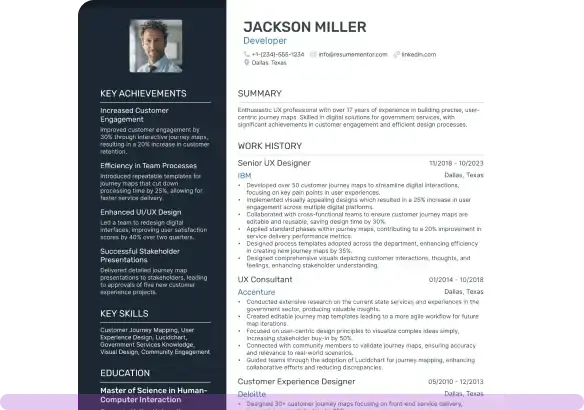Art Director Resume Examples
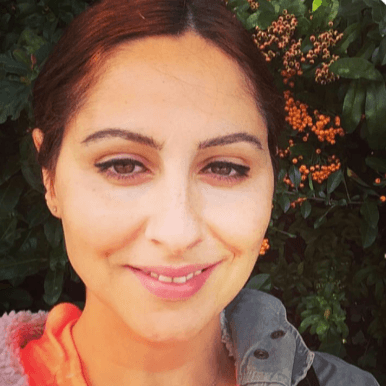
Mar 26, 2025
|
12 min read
Create a stellar art director resume that paints your career in the best light. Master techniques to frame your experience, skills, and achievements. Stand out to hiring managers with creativity and professionalism. Get ready to direct your job success!
Rated by 348 people
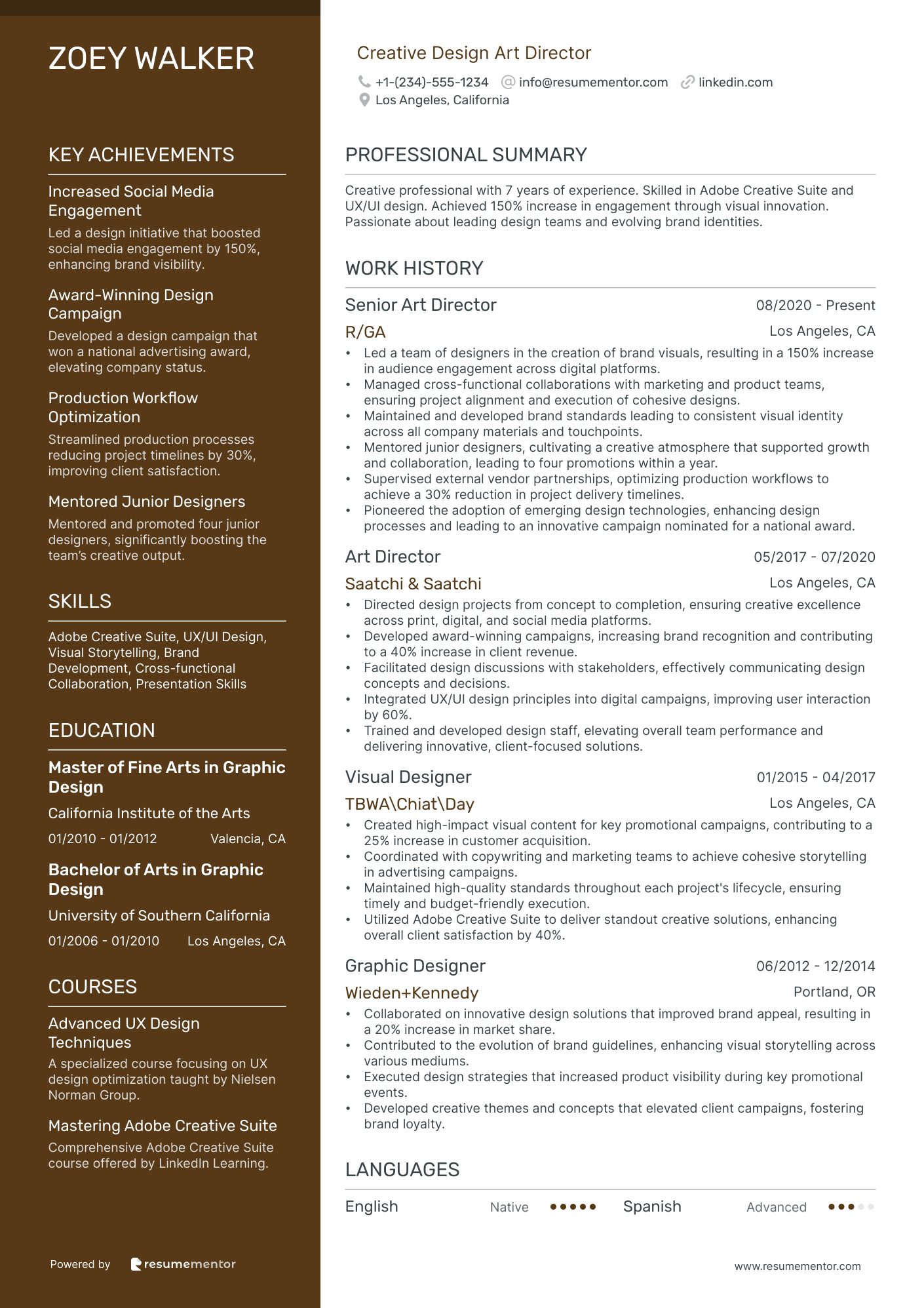
Creative Design Art Director

Animation Art Director
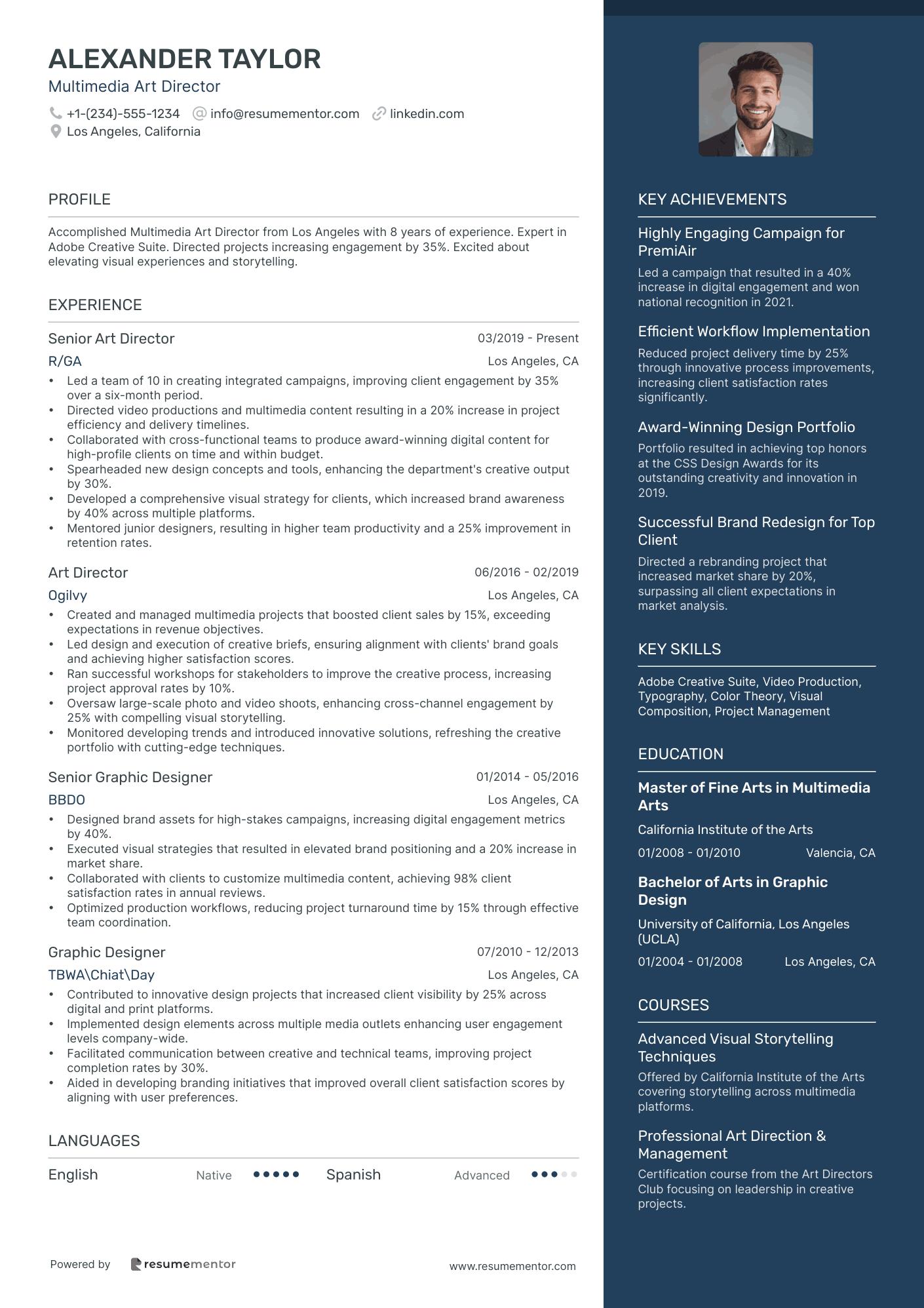
Multimedia Art Director
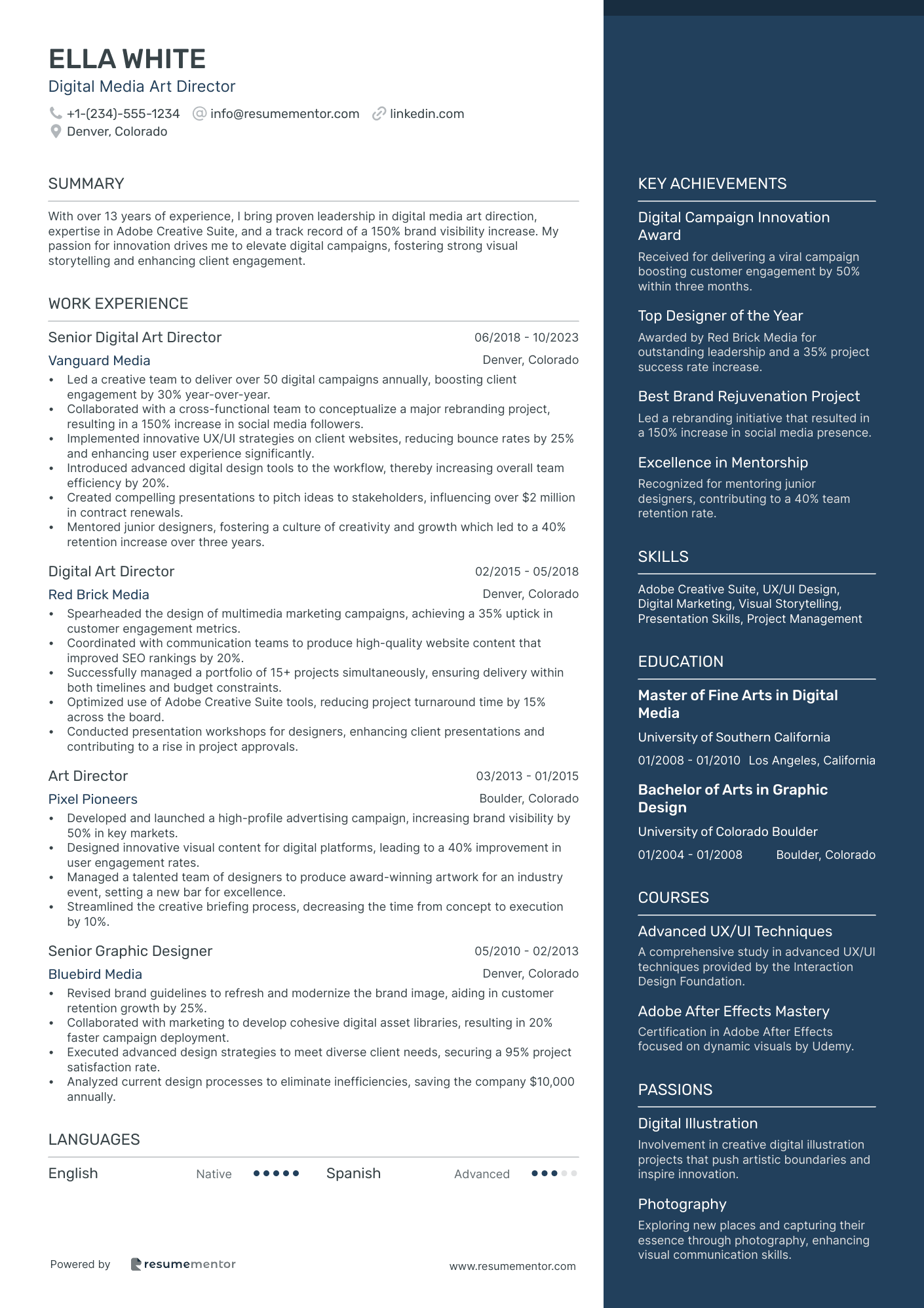
Digital Media Art Director
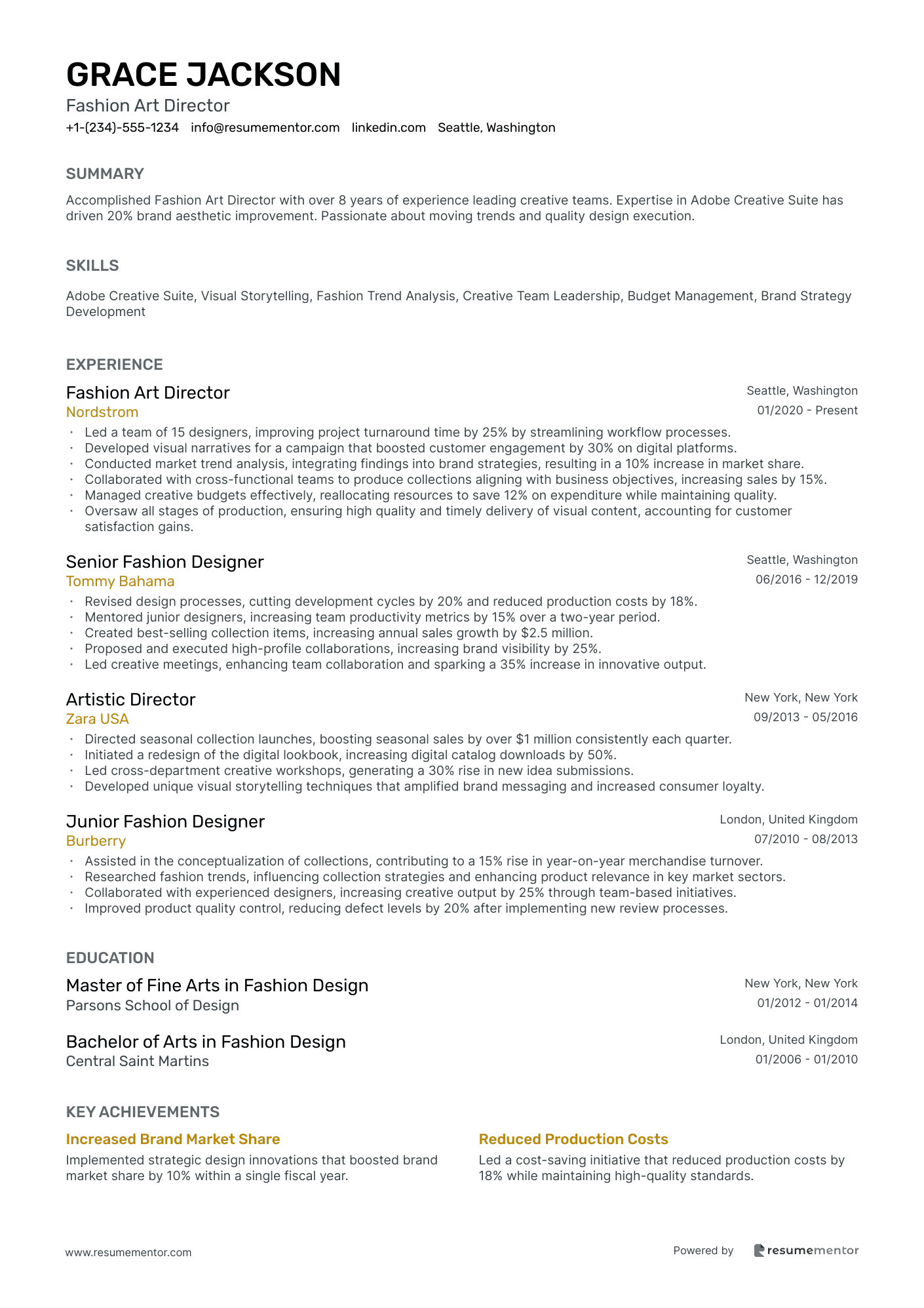
Fashion Art Director

Brand Identity Art Director
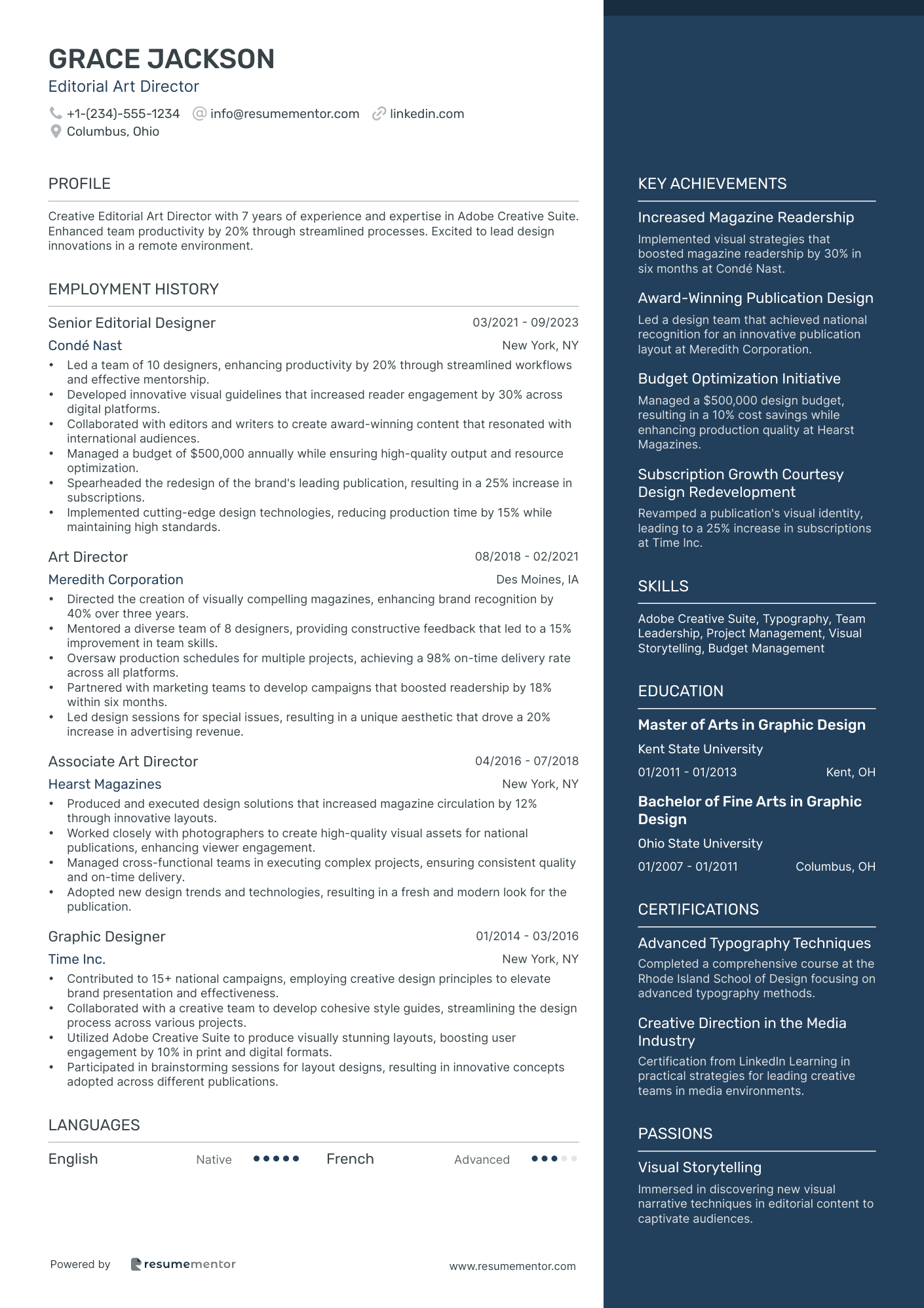
Editorial Art Director
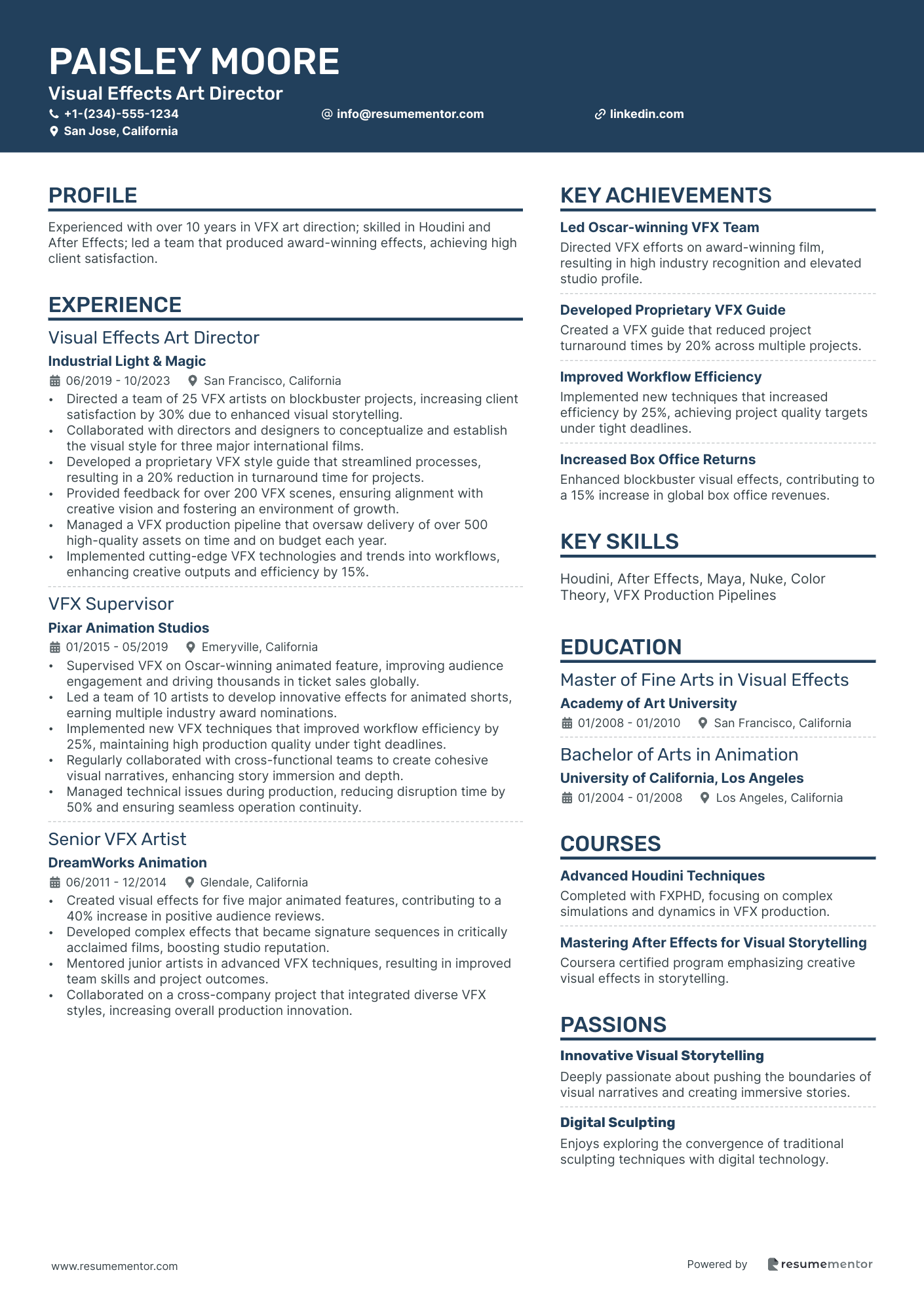
Visual Effects Art Director

Graphic Art Director
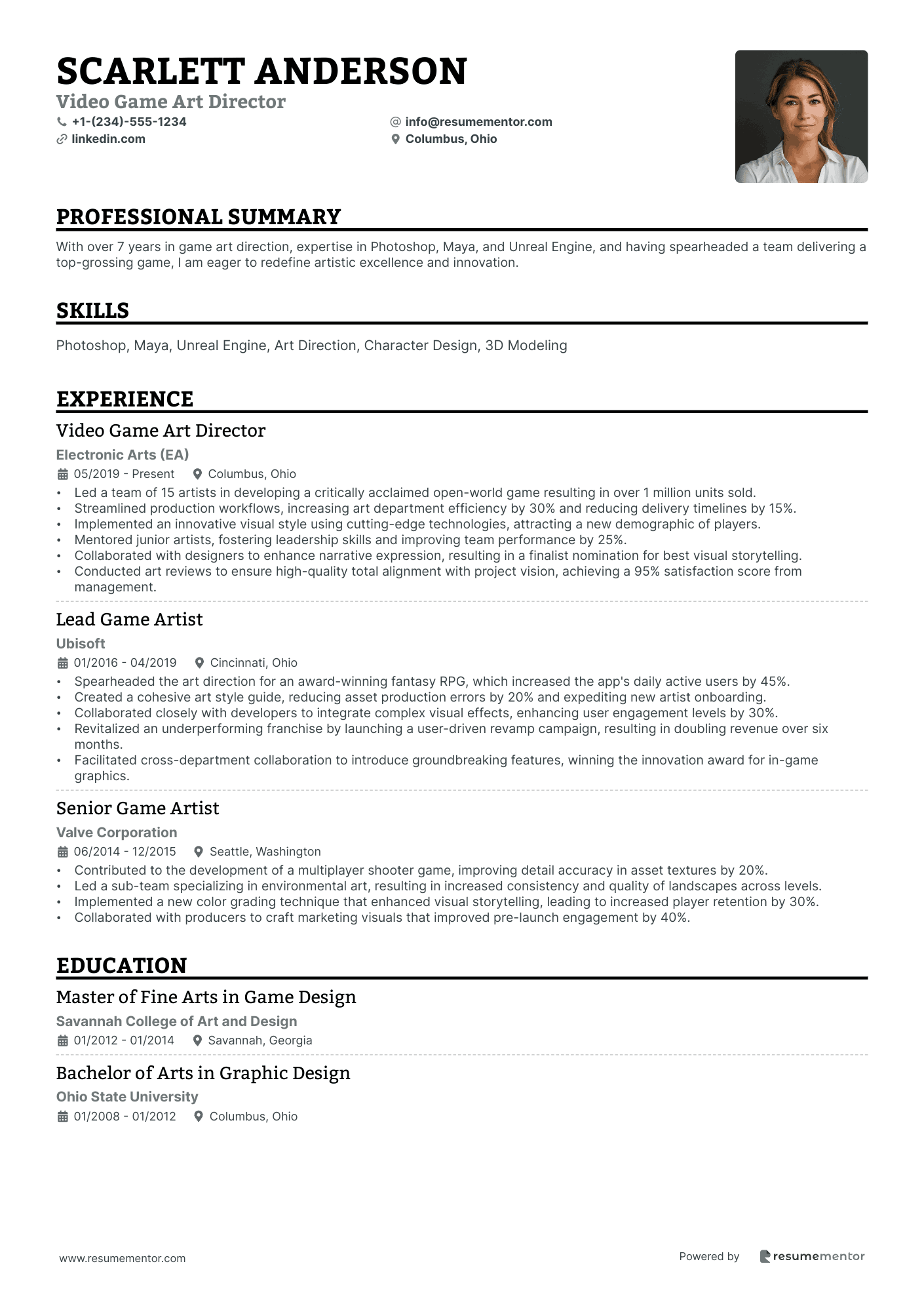
Video Game Art Director
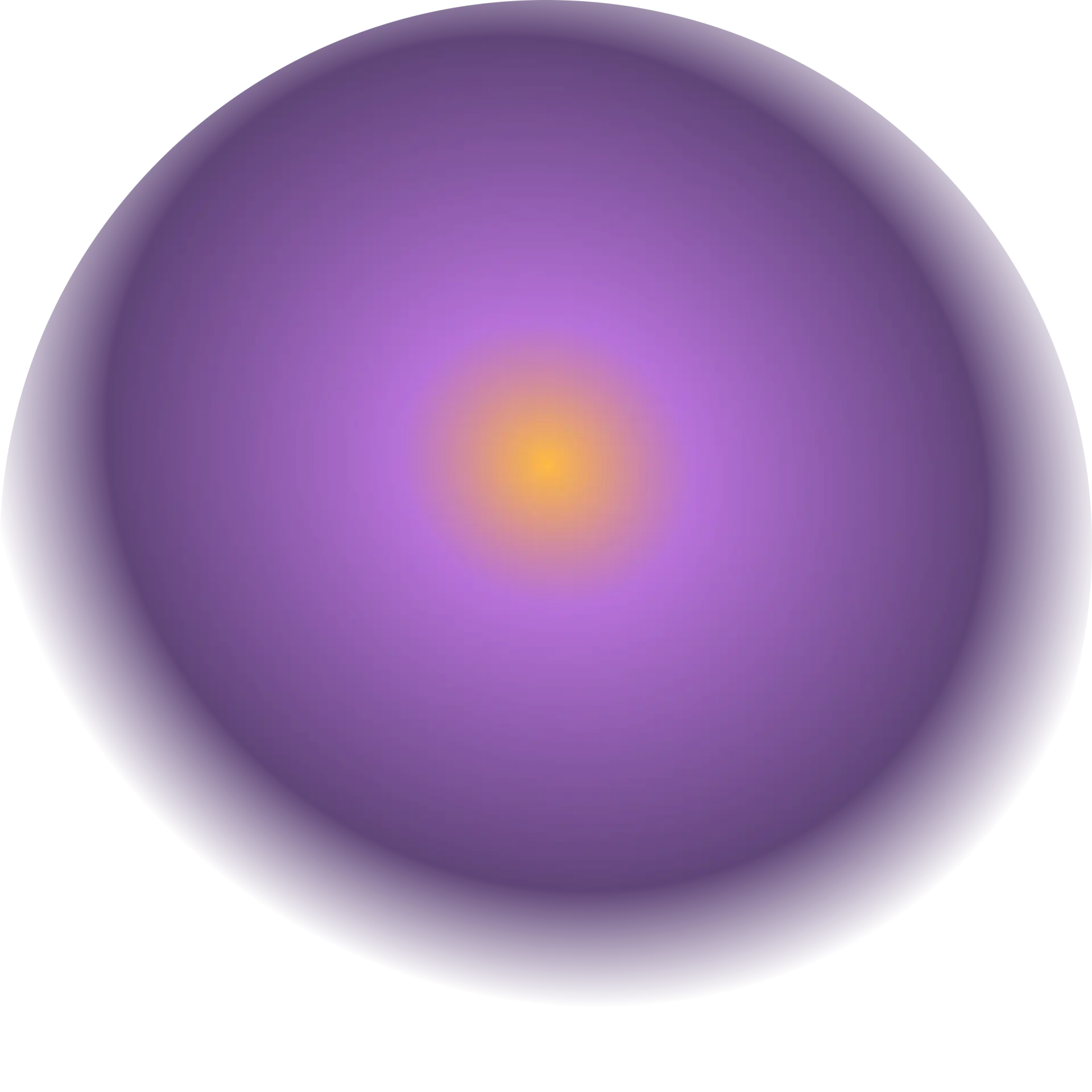
Creative Design Art Director resume sample
- •Led a team of designers in the creation of brand visuals, resulting in a 150% increase in audience engagement across digital platforms.
- •Managed cross-functional collaborations with marketing and product teams, ensuring project alignment and execution of cohesive designs.
- •Maintained and developed brand standards leading to consistent visual identity across all company materials and touchpoints.
- •Mentored junior designers, cultivating a creative atmosphere that supported growth and collaboration, leading to four promotions within a year.
- •Supervised external vendor partnerships, optimizing production workflows to achieve a 30% reduction in project delivery timelines.
- •Pioneered the adoption of emerging design technologies, enhancing design processes and leading to an innovative campaign nominated for a national award.
- •Directed design projects from concept to completion, ensuring creative excellence across print, digital, and social media platforms.
- •Developed award-winning campaigns, increasing brand recognition and contributing to a 40% increase in client revenue.
- •Facilitated design discussions with stakeholders, effectively communicating design concepts and decisions.
- •Integrated UX/UI design principles into digital campaigns, improving user interaction by 60%.
- •Trained and developed design staff, elevating overall team performance and delivering innovative, client-focused solutions.
- •Created high-impact visual content for key promotional campaigns, contributing to a 25% increase in customer acquisition.
- •Coordinated with copywriting and marketing teams to achieve cohesive storytelling in advertising campaigns.
- •Maintained high-quality standards throughout each project's lifecycle, ensuring timely and budget-friendly execution.
- •Utilized Adobe Creative Suite to deliver standout creative solutions, enhancing overall client satisfaction by 40%.
- •Collaborated on innovative design solutions that improved brand appeal, resulting in a 20% increase in market share.
- •Contributed to the evolution of brand guidelines, enhancing visual storytelling across various mediums.
- •Executed design strategies that increased product visibility during key promotional events.
- •Developed creative themes and concepts that elevated client campaigns, fostering brand loyalty.
Animation Art Director resume sample
- •Spearheaded a multidisciplinary team of 20 to create a feature-length animation that increased engagement by 40%.
- •Defined the visual style for three main animation projects, maintaining consistent quality and aligning with client objectives.
- •Oversaw production of over 500 animation assets, ensuring adherence to tight deadlines and quality standards.
- •Implemented new animation techniques through workshops, improving team's efficiency by 30%.
- •Collaborated on successful project pitch that resulted in a $5 million contract for a new animated series.
- •Delivered weekly feedback to all team members, fostering a culture of continuous improvement and creative growth.
- •Led the animation team in the production of a top-grossing animated film, resulting in a 35% increase in box office sales.
- •Innovated character designs and visual effects that boosted the project’s visual appeal and critical acclaim.
- •Developed training modules for new hires, improving onboarding process and reducing ramp-up time by 20%.
- •Collaborated extensively with storyboard and sound design teams to ensure cohesive storytelling for three projects.
- •Enhanced team skillsets by transitioning to the latest animation software tools, ensuring 100% adaptation within two months.
- •Developed unique visual effects in a major project, contributing to a 50% increase in viewership ratings.
- •Managed timelines for the animation team on four short films, ensuring delivery before deadlines.
- •Introduced innovative animation techniques that resulted in the reduction of render times by 15%.
- •Supported junior animators with constructive feedback, promoting a collaborative and creative work environment.
- •Contributed to the animation of two award-winning films, receiving substantial acclaim for artistic style.
- •Collaborated with multi-functional teams to produce industry-leading animation assets on budget.
- •Participated in daily stand-up meetings, increasing team communication effectiveness by 25%.
- •Delegated specific animation tasks to junior team members, optimizing team workflow by 20%.
Multimedia Art Director resume sample
- •Led a team of 10 in creating integrated campaigns, improving client engagement by 35% over a six-month period.
- •Directed video productions and multimedia content resulting in a 20% increase in project efficiency and delivery timelines.
- •Collaborated with cross-functional teams to produce award-winning digital content for high-profile clients on time and within budget.
- •Spearheaded new design concepts and tools, enhancing the department's creative output by 30%.
- •Developed a comprehensive visual strategy for clients, which increased brand awareness by 40% across multiple platforms.
- •Mentored junior designers, resulting in higher team productivity and a 25% improvement in retention rates.
- •Created and managed multimedia projects that boosted client sales by 15%, exceeding expectations in revenue objectives.
- •Led design and execution of creative briefs, ensuring alignment with clients' brand goals and achieving higher satisfaction scores.
- •Ran successful workshops for stakeholders to improve the creative process, increasing project approval rates by 10%.
- •Oversaw large-scale photo and video shoots, enhancing cross-channel engagement by 25% with compelling visual storytelling.
- •Monitored developing trends and introduced innovative solutions, refreshing the creative portfolio with cutting-edge techniques.
- •Designed brand assets for high-stakes campaigns, increasing digital engagement metrics by 40%.
- •Executed visual strategies that resulted in elevated brand positioning and a 20% increase in market share.
- •Collaborated with clients to customize multimedia content, achieving 98% client satisfaction rates in annual reviews.
- •Optimized production workflows, reducing project turnaround time by 15% through effective team coordination.
- •Contributed to innovative design projects that increased client visibility by 25% across digital and print platforms.
- •Implemented design elements across multiple media outlets enhancing user engagement levels company-wide.
- •Facilitated communication between creative and technical teams, improving project completion rates by 30%.
- •Aided in developing branding initiatives that improved overall client satisfaction scores by aligning with user preferences.
Digital Media Art Director resume sample
- •Led a creative team to deliver over 50 digital campaigns annually, boosting client engagement by 30% year-over-year.
- •Collaborated with a cross-functional team to conceptualize a major rebranding project, resulting in a 150% increase in social media followers.
- •Implemented innovative UX/UI strategies on client websites, reducing bounce rates by 25% and enhancing user experience significantly.
- •Introduced advanced digital design tools to the workflow, thereby increasing overall team efficiency by 20%.
- •Created compelling presentations to pitch ideas to stakeholders, influencing over $2 million in contract renewals.
- •Mentored junior designers, fostering a culture of creativity and growth which led to a 40% retention increase over three years.
- •Spearheaded the design of multimedia marketing campaigns, achieving a 35% uptick in customer engagement metrics.
- •Coordinated with communication teams to produce high-quality website content that improved SEO rankings by 20%.
- •Successfully managed a portfolio of 15+ projects simultaneously, ensuring delivery within both timelines and budget constraints.
- •Optimized use of Adobe Creative Suite tools, reducing project turnaround time by 15% across the board.
- •Conducted presentation workshops for designers, enhancing client presentations and contributing to a rise in project approvals.
- •Developed and launched a high-profile advertising campaign, increasing brand visibility by 50% in key markets.
- •Designed innovative visual content for digital platforms, leading to a 40% improvement in user engagement rates.
- •Managed a talented team of designers to produce award-winning artwork for an industry event, setting a new bar for excellence.
- •Streamlined the creative briefing process, decreasing the time from concept to execution by 10%.
- •Revised brand guidelines to refresh and modernize the brand image, aiding in customer retention growth by 25%.
- •Collaborated with marketing to develop cohesive digital asset libraries, resulting in 20% faster campaign deployment.
- •Executed advanced design strategies to meet diverse client needs, securing a 95% project satisfaction rate.
- •Analyzed current design processes to eliminate inefficiencies, saving the company $10,000 annually.
Fashion Art Director resume sample
- •Led a team of 15 designers, improving project turnaround time by 25% by streamlining workflow processes.
- •Developed visual narratives for a campaign that boosted customer engagement by 30% on digital platforms.
- •Conducted market trend analysis, integrating findings into brand strategies, resulting in a 10% increase in market share.
- •Collaborated with cross-functional teams to produce collections aligning with business objectives, increasing sales by 15%.
- •Managed creative budgets effectively, reallocating resources to save 12% on expenditure while maintaining quality.
- •Oversaw all stages of production, ensuring high quality and timely delivery of visual content, accounting for customer satisfaction gains.
- •Revised design processes, cutting development cycles by 20% and reduced production costs by 18%.
- •Mentored junior designers, increasing team productivity metrics by 15% over a two-year period.
- •Created best-selling collection items, increasing annual sales growth by $2.5 million.
- •Proposed and executed high-profile collaborations, increasing brand visibility by 25%.
- •Led creative meetings, enhancing team collaboration and sparking a 35% increase in innovative output.
- •Directed seasonal collection launches, boosting seasonal sales by over $1 million consistently each quarter.
- •Initiated a redesign of the digital lookbook, increasing digital catalog downloads by 50%.
- •Led cross-department creative workshops, generating a 30% rise in new idea submissions.
- •Developed unique visual storytelling techniques that amplified brand messaging and increased consumer loyalty.
- •Assisted in the conceptualization of collections, contributing to a 15% rise in year-on-year merchandise turnover.
- •Researched fashion trends, influencing collection strategies and enhancing product relevance in key market sectors.
- •Collaborated with experienced designers, increasing creative output by 25% through team-based initiatives.
- •Improved product quality control, reducing defect levels by 20% after implementing new review processes.
Brand Identity Art Director resume sample
- •Led a team of 8 designers, increasing team productivity by 25% through structured project management and motivational techniques.
- •Redesigned brand collateral for a major client, resulting in a 30% increase in consumer engagement and brand recognition.
- •Implemented a consistent brand identity across digital platforms, cutting production inefficiencies by 20% over the last year.
- •Collaborated with marketing and development teams to launch a multi-channel campaign that boosted sales by 15% in its first quarter.
- •Presented design concepts to stakeholders, successfully incorporating feedback to enhance user experience and brand consistency.
- •Streamlined the design production process by partnering with external vendors, ensuring 100% adherence to our quality standards.
- •Developed comprehensive visual identity systems for several key clients, contributing to a 40% growth in their brand visibility.
- •Supervised and mentored a team of 5 junior designers, enhancing their skill development and project execution efficiency.
- •Worked closely with cross-functional teams to produce compelling print and digital assets, helping increase client retention by 10%.
- •Conducted market trend analyses to inform design decisions, considerably improving the relevance and reach of client campaigns.
- •Enhanced design turnaround time by 15% by optimizing workflow processes and adopting innovative design tools.
- •Conceptualized and executed multiple award-winning advertising campaigns, significantly elevating brand prestige and industry standing.
- •Initiated a cross-departmental collaboration model that improved project turnarounds and client satisfaction by 20%.
- •Spearheaded design workshops that fostered innovation, leading to a 33% increase in creative output quality.
- •Managed budget and timelines effectively, ensuring all projects were delivered on time and within budget constraints.
- •Assisted in creating cohesive brand identity packages for high-profile clients, enhancing their market recognition by 25%.
- •Edited and refined digital marketing materials, which helped increase web traffic and engagement metrics by 20% over a year.
- •Implemented innovative design technologies that reduced production time by 15% across various projects.
- •Provided creative support for senior designers, consistently meeting tight deadlines and maintaining high-quality standards.
Editorial Art Director resume sample
- •Led a team of 10 designers, enhancing productivity by 20% through streamlined workflows and effective mentorship.
- •Developed innovative visual guidelines that increased reader engagement by 30% across digital platforms.
- •Collaborated with editors and writers to create award-winning content that resonated with international audiences.
- •Managed a budget of $500,000 annually while ensuring high-quality output and resource optimization.
- •Spearheaded the redesign of the brand's leading publication, resulting in a 25% increase in subscriptions.
- •Implemented cutting-edge design technologies, reducing production time by 15% while maintaining high standards.
- •Directed the creation of visually compelling magazines, enhancing brand recognition by 40% over three years.
- •Mentored a diverse team of 8 designers, providing constructive feedback that led to a 15% improvement in team skills.
- •Oversaw production schedules for multiple projects, achieving a 98% on-time delivery rate across all platforms.
- •Partnered with marketing teams to develop campaigns that boosted readership by 18% within six months.
- •Led design sessions for special issues, resulting in a unique aesthetic that drove a 20% increase in advertising revenue.
- •Produced and executed design solutions that increased magazine circulation by 12% through innovative layouts.
- •Worked closely with photographers to create high-quality visual assets for national publications, enhancing viewer engagement.
- •Managed cross-functional teams in executing complex projects, ensuring consistent quality and on-time delivery.
- •Adopted new design trends and technologies, resulting in a fresh and modern look for the publication.
- •Contributed to 15+ national campaigns, employing creative design principles to elevate brand presentation and effectiveness.
- •Collaborated with a creative team to develop cohesive style guides, streamlining the design process across various projects.
- •Utilized Adobe Creative Suite to produce visually stunning layouts, boosting user engagement by 10% in print and digital formats.
- •Participated in brainstorming sessions for layout designs, resulting in innovative concepts adopted across different publications.
Visual Effects Art Director resume sample
- •Directed a team of 25 VFX artists on blockbuster projects, increasing client satisfaction by 30% due to enhanced visual storytelling.
- •Collaborated with directors and designers to conceptualize and establish the visual style for three major international films.
- •Developed a proprietary VFX style guide that streamlined processes, resulting in a 20% reduction in turnaround time for projects.
- •Provided feedback for over 200 VFX scenes, ensuring alignment with creative vision and fostering an environment of growth.
- •Managed a VFX production pipeline that oversaw delivery of over 500 high-quality assets on time and on budget each year.
- •Implemented cutting-edge VFX technologies and trends into workflows, enhancing creative outputs and efficiency by 15%.
- •Supervised VFX on Oscar-winning animated feature, improving audience engagement and driving thousands in ticket sales globally.
- •Led a team of 10 artists to develop innovative effects for animated shorts, earning multiple industry award nominations.
- •Implemented new VFX techniques that improved workflow efficiency by 25%, maintaining high production quality under tight deadlines.
- •Regularly collaborated with cross-functional teams to create cohesive visual narratives, enhancing story immersion and depth.
- •Managed technical issues during production, reducing disruption time by 50% and ensuring seamless operation continuity.
- •Created visual effects for five major animated features, contributing to a 40% increase in positive audience reviews.
- •Developed complex effects that became signature sequences in critically acclaimed films, boosting studio reputation.
- •Mentored junior artists in advanced VFX techniques, resulting in improved team skills and project outcomes.
- •Collaborated on a cross-company project that integrated diverse VFX styles, increasing overall production innovation.
- •Produced VFX for blockbuster films, enhancing visual engagement which supported a 15% increase in box office returns.
- •Integrated new visual effects technologies, improving the quality of deliverables and reducing production time by 10%.
- •Collaborated with directors to align VFX with narrative goals, ensuring continuity and enrichment of the story.
- •Established a comprehensive VFX asset library, standardizing resources and increasing team efficiency by 20%.
Graphic Art Director resume sample
- •Led a team of 10 designers to deliver visual strategies that increased brand engagement by 30% within a year.
- •Managed cross-functional projects with marketing and product teams, contributing to a 15% rise in customer acquisition rates.
- •Conducted workshops to align design output with industry trends, resulting in a 40% reduction in project completion times.
- •Implemented mentorship programs that improved team creativity and reduced turnover by 25% over two years.
- •Presented compelling design concepts to stakeholders, enhancing project approval rates by 20% through clear communication and strategic insights.
- •Coordinated diverse design projects, managing timelines and budgets effectively to consistently achieve targets.
- •Developed cohesive design guides that standardized brand elements across all media, improving brand recognition by 18%.
- •Facilitated cross-departmental collaborations which led to the successful launch of three major campaigns within budget.
- •Streamlined the design process by implementing new software tools, decreasing project timeframes by 20% on average.
- •Mentored junior designers, helping them achieve personal growth and enhancing team performance metrics by 15%.
- •Prepared visual proposals and strategies, effectively communicating design logic to increase client approvals by 10%.
- •Executed design projects that adhered to brand guidelines, contributing to a 12% rise in campaign effectiveness.
- •Collaborated with marketing teams to create assets that improved web traffic by 20% over six months.
- •Redesigned key visual elements for product packaging, leading to a 25% increase in consumer engagement.
- •Coordinated with external vendors to streamline the print production process, minimizing errors and reducing costs by 10%.
- •Supported senior designers in executing projects that heightened brand visibility by 15% through innovative visuals.
- •Assisted in the development of digital assets, contributing to an enhanced user experience and site retention rates.
- •Participated in brainstorming sessions that resulted in actionable creative outputs, increasing project pitch success rates by 10%.
- •Provided analytical insights to design reports, leading to improved strategic planning and execution in subsequent projects.
Video Game Art Director resume sample
- •Led a team of 15 artists in developing a critically acclaimed open-world game resulting in over 1 million units sold.
- •Streamlined production workflows, increasing art department efficiency by 30% and reducing delivery timelines by 15%.
- •Implemented an innovative visual style using cutting-edge technologies, attracting a new demographic of players.
- •Mentored junior artists, fostering leadership skills and improving team performance by 25%.
- •Collaborated with designers to enhance narrative expression, resulting in a finalist nomination for best visual storytelling.
- •Conducted art reviews to ensure high-quality total alignment with project vision, achieving a 95% satisfaction score from management.
- •Spearheaded the art direction for an award-winning fantasy RPG, which increased the app's daily active users by 45%.
- •Created a cohesive art style guide, reducing asset production errors by 20% and expediting new artist onboarding.
- •Collaborated closely with developers to integrate complex visual effects, enhancing user engagement levels by 30%.
- •Revitalized an underperforming franchise by launching a user-driven revamp campaign, resulting in doubling revenue over six months.
- •Facilitated cross-department collaboration to introduce groundbreaking features, winning the innovation award for in-game graphics.
- •Contributed to the development of a multiplayer shooter game, improving detail accuracy in asset textures by 20%.
- •Led a sub-team specializing in environmental art, resulting in increased consistency and quality of landscapes across levels.
- •Implemented a new color grading technique that enhanced visual storytelling, leading to increased player retention by 30%.
- •Collaborated with producers to craft marketing visuals that improved pre-launch engagement by 40%.
Crafting a compelling art director resume is like designing a masterpiece—you have the creativity, but turning that into words can be tough. The art director role requires both creative flair and technical expertise, and capturing that balance on paper can be challenging. Knowing which projects to highlight and how to present your skills can feel like navigating a maze.
To make this task easier, start by finding a structure that showcases your unique talents effectively. Using a resume template can provide the solid foundation you need. This selection of templates will help you organize your experience into a clear and visually appealing narrative, making it easier to showcase your creativity.
Focus on presenting your achievements in measurable terms to demonstrate your impact. Highlight how your vision has boosted past projects or improved team performance. Employers seek tangible results, so showing the concrete impact of your creativity is crucial.
Every line of your resume should have a clear purpose, so keep it concise and ensure your strongest points stand out. Think of your resume as a storyboard, where each section contributes to the story of your professional journey in art direction. With the right template and focus on your unique skills and accomplishments, your resume can truly shine.
Key Takeaways
- Crafting a compelling art director resume requires a balance of creativity and technical expertise, with a focus on effectively highlighting unique talents and achievements.
- Employers value measurable achievements, so showcasing the concrete impact of your creativity through specific results is essential.
- A concise and purposeful resume, using templates and focusing on relevant and recent work, can help underscore growth and impact in art direction roles.
- Incorporating both hard and soft skills, along with a clear summary that outlines key achievements, ensures your resume stands out to employers.
- Additional sections such as certifications, volunteer work, and personal interests can provide a competitive edge, reflecting a well-rounded and dedicated professional profile.
What to focus on when writing your art director resume
An art director resume should effectively communicate your creativity, leadership, and project management skills to the recruiter. The document needs to highlight your ability to develop visual concepts and manage design projects while effectively collaborating with a team to achieve shared goals.
How to structure your art director resume
- Contact Information: Start with your name, phone number, email address, and LinkedIn profile so recruiters can easily get in touch with you. Make sure your LinkedIn profile is updated and aligns with the information on your resume—consistency builds trust and professionalism.
- Professional Summary: Follow with a concise summary that emphasizes your experience in art direction and the impact you've made on various projects. Including a mention of a specific style or niche experience can set your resume apart. A well-crafted summary sets the tone for your resume and piques interest in your unique talents.
- Work Experience: In this section, list relevant positions, detailing the company name, location, job title, and dates. Be sure to include specific achievements, such as leading a design team that enhanced brand recognition by 30%, to illustrate your impact. Numbers and results can put your achievements into perspective, showing potential employers the value you bring.
- Skills: Focus on your artistic and leadership qualities next. Highlight abilities like creative strategy development, team collaboration, and your proficiency with design tools such as Adobe Creative Suite. These skills emphasize your technical capability and your ability to lead and inspire a team, which are crucial for an art director.
- Education: Then, include details about your degree, the institution, and your graduation date. Relevant coursework or honors that pertain to art direction can further underscore your qualifications. This section helps solidify your foundation in the principles of art and design, showing your preparedness for the role.
- Portfolio Link: Wrap up with a link to an online portfolio that showcases your best work, demonstrating a range of styles and projects. This visual showcase is often the turning point for employers, providing evidence of your aesthetic sensibility and technical skills. Now that you have an overview, it’s time to delve deeper into the specifics of each section—understanding the ideal resume format will ensure that your content shines.
Which resume format to choose
As an art director, your resume should seamlessly blend creativity and professionalism. Begin with the reverse-chronological format, which naturally showcases your most recent roles and achievements. This format is particularly effective for highlighting career growth and the depth of your experience as it places your latest and most impressive work at the forefront. When choosing fonts, opt for modern options like Raleway, Montserrat, or Chivo. These fonts offer a clean, stylish look that aligns with the innovative nature of the art industry while standing out against traditional choices like Arial or Times New Roman. To ensure your resume's design remains intact on any device, always save it as a PDF. This file type guarantees that your carefully crafted layout is preserved, reflecting your attention to detail and design aesthetics. Maintain one-inch margins all around to present your content neatly, which not only frames your information beautifully but also enhances readability. This approach ensures your professional brand is presented clearly and effectively, making it straightforward for employers to grasp your qualifications.
How to write a quantifiable resume experience section
For an art director resume, the experience section is vital as it highlights past roles and demonstrates your leadership and creativity. By starting with your most recent position, you ensure that the most relevant experience is at the top, making it easier for employers to see your growth. Focusing on the last 10-15 years of your career keeps the content relevant and shows a clear trajectory toward the art director role. When you choose job titles that reflect your advancement, you're already aligning your experience with what employers seek. Tailoring each entry to match the job ad and using powerful action words like "led," "developed," "increased," and "produced" gives the hiring manager concrete reasons to consider you as the perfect fit for their needs.
- •Increased client satisfaction by 30% with innovative branding strategies.
- •Led a team of 10 designers, improving campaign turnaround times by 50%.
- •Boosted brand visibility by 40% with a successful multi-channel marketing campaign.
- •Produced award-winning work that drove a 20% growth in client acquisition.
This experience section excels because it seamlessly links your leadership and creative impact with measurable achievements. Each bullet point connects directly to specific outcomes, reinforcing your ability to lead projects and inspire your team. The action-oriented language naturally ties your accomplishments to the needs of potential employers, showing them that your contribution can drive success. By tailoring the content to the job ad, you ensure that every detail aligns with what the employer is looking for, making your resume not just a list of experiences but a clear narrative of growth and impact.
Skills-Focused resume experience section
A skills-focused art director resume experience section should clearly highlight your most important strengths and achievements. Concentrate on the skills that were crucial to your past successes and how they set you apart. Use strong action verbs and specific details to make your accomplishments stand out, providing future employers with clear examples of your contributions and impact. Rather than just listing tasks, demonstrate how your skills led to improved team performance or project outcomes.
Ensure your resume flows naturally, guiding employers through the highlights of your career that are relevant to art direction. Make sure your examples are specific and focus on your role in making a difference, showcasing your personal impact. Keep the information concise and easy to read, as employers appreciate clarity and directness. Here's how such an example might look:
Art Director
CreativeWorks Studio
June 2018 - August 2023
- Led a design team of 10 to deliver campaigns that increased client engagement by 30%.
- Developed innovative design strategies that won three industry awards.
- Reduced project turnaround times by 20% through optimized workflow processes.
- Mentored junior designers, leading to a 50% increase in their project contributions.
Collaboration-Focused resume experience section
A collaboration-focused art director resume experience section should effectively highlight your skills in teamwork and achieving creative success through shared efforts. Identify projects where you played a significant role in steering the team creatively, ensuring that everyone worked toward the common goals. Highlight your ability to manage team dynamics and maintain alignment, especially when overseeing a diverse group of designers, copywriters, or other creatives. Use vivid language to show how you fostered a cooperative environment, bringing together varied perspectives for a successful outcome.
Your bullet points should be clear and connect your actions to the achievements and processes, rather than just listing duties. Detail how your efforts boosted team success, making sure to include metrics or results for a tangible sense of impact. This approach allows potential employers to understand not only what you've accomplished, but also how your collaborative nature has significantly benefited projects and previous companies.
Art Director
Creative Minds Studio
March 2020 - April 2023
- Guided a team of 5 designers and managed cross-functional collaborations, which elevated project outcomes and ensured alignment with the client’s vision.
- Streamlined communication across teams using agile methodologies, speeding up project timelines by 20%.
- Fostered an inclusive environment where team members contributed ideas freely, resulting in an award-winning campaign.
- Implemented feedback loops that increased designer satisfaction and led to a noticeable improvement in creative output.
Growth-Focused resume experience section
A growth-focused art director resume experience section should tell the story of how you've pushed projects forward and made a significant impact. Start by showcasing accomplishments that demonstrate your leadership and creativity, using action words and clear results to highlight your influence. It's important to emphasize specific projects where you've guided a team to achieve company goals, illustrating not only your management skills but also your strategic thinking toward growth and development.
When you detail your experiences, keep the focus on your main responsibilities while highlighting key achievements. Art directors often handle multiple projects, so zero in on those with the most impressive results. Share how you've worked alongside other departments to contribute to overall success, using bullet points for clarity and conciseness. Ensure every point adds value, and tailor your experiences to align with the jobs you’re applying for, helping your resume stand out from the crowd.
Art Director
Creatix Studios
Jan 2020 - Present
- Led a team of designers to revamp the company's digital ad campaigns, boosting engagement rates by 35%.
- Worked closely with the marketing team to create themes that align with brand goals and resonate with the audience.
- Introduced project management tools to streamline tasks, cutting down completion time by 20%.
- Created a collaborative environment that sparked innovative ideas, leading to a 15% increase in creative output.
Technology-Focused resume experience section
A technology-focused art director resume experience section should illustrate how you skillfully combine creativity and technical expertise. Begin by selecting a project or job role that highlights your strengths in both areas, using bullet points to showcase your achievements. Ensure each point reflects quantifiable successes and specific projects, demonstrating your ability to lead creative teams in tech-driven environments.
Focus on showcasing your problem-solving skills and how you apply art direction techniques across various digital platforms. Highlight your collaborations with tech teams to introduce innovative design elements that enhance project outcomes. Include any specialized software or tools you have mastered, and connect these skills to your achievements. This approach will paint a vivid picture of your capabilities and accomplishments.
Senior Art Director
Tech Innovators Inc.
June 2018 - Present
- Led a creative team to develop a new app interface, boosting user engagement by 30%.
- Teamed up with IT to add VR elements to campaigns, enhancing audience interaction.
- Managed digital assets to ensure seamless performance across mobile and web.
- Streamlined design processes with new project management software, reducing production time by 20%.
Write your art director resume summary section
A creatively-focused art director resume summary should grab attention from the start. Begin by showcasing your major achievements and unique skills to make your career stand out. In a few impactful sentences, link your past experiences directly to the new role you’re aiming for. It's crucial to emphasize your creative vision alongside your leadership qualities. Each effective summary reflects the candidate's level of experience. By highlighting key accomplishments, you underline their significance to your career growth. Ensure you touch upon your knowledge of industry trends, too. Leadership experience is essential, especially if you’ve had the chance to guide a team. For art directors, an eye for detail and creative flair are vital, so make sure these traits shine through. Point out your role in successful projects and demonstrate how your skills made a difference. Keep your summary simple yet informative, to effectively convey your creativity and project management capabilities.
Here's an example of a compelling art director resume summary:
Understanding the differences between a resume summary and other sections can improve your application. While a resume summary benefits experienced professionals, a resume objective suits those entering a new field or transitioning careers. A resume profile ties together skills and experience in a wider statement, and a summary of qualifications offers a bullet point list of key skills. Each serves a unique purpose in showcasing your abilities and experiences tailored to the job at hand.
Listing your art director skills on your resume
A skills-focused art director resume should highlight your capabilities in a way that grabs attention. You can either dedicate a specific section to your skills or blend them seamlessly into your experience and summary. Showcasing your strengths, such as creativity and leadership, alongside specific hard skills like software expertise, demonstrates your potential impact. These hard skills refer to teachable abilities, such as project management and software proficiency, that enhance your technical appeal. Including both skills and strengths ensures your resume is optimized with the keywords employers look for.
Here’s an example of an effective skills section:
This section makes your qualifications clear and easy to identify. Each skill is relevant and essential for an art director, capturing the attention of hiring managers quickly and effectively. Moreover, the list serves as key terms that not only describe your capabilities but also align with what employers seek.
Best hard skills to feature on your art director resume
Mastering specific abilities and tools is crucial for an art director. Hard skills such as software competence, art techniques, and project coordination demonstrate your technical know-how.
Hard Skills
- Adobe Creative Suite
- Graphic Design
- Typography
- Digital Illustration
- Branding
- Visual Communication
- Project Management
- Video Editing
- Print Design
- Color Theory
- UX/UI Design
- Photography
- 3D Modeling
- Art Direction
- Motion Graphics
Best soft skills to feature on your art director resume
Your soft skills reflect your interpersonal and leadership abilities. They illustrate how effectively you can collaborate with others and guide a team to success.
Soft Skills
- Creativity
- Communication
- Leadership
- Team Collaboration
- Problem Solving
- Time Management
- Adaptability
- Attention to Detail
- Critical Thinking
- Decision Making
- Interpersonal Skills
- Flexibility
- Conflict Resolution
- Motivation
- Empathy
How to include your education on your resume
The education section of your resume is crucial. It shows your qualifications and sets the tone for your experience as an art director. Tailor this section to the specific job you are applying for. Only include relevant education and leave out anything that doesn't add value to your application. If your GPA is above 3.0, consider including it. List it as follows: "GPA: 3.8/4.0". If you graduated with honors, such as cum laude, make sure to note this distinction clearly by adding "cum laude" afterward. When listing your degree, state your major, the institution, and the graduation date.
The second example is strong because it highlights a degree relevant to art direction. It mentions honors, indicating academic excellence, which can appeal to employers. The relevant field of study and institution known for arts add credibility. The GPA shows the candidate's dedication and success. Every detail included supports the main objective: demonstrating suitability for an art director role.
How to include art director certificates on your resume
Including a certificates section on your resume is crucial, especially for an art director role. Such certifications can reflect your qualifications and ongoing commitment to professional growth. Start by listing the name of each certificate, being specific about what you have achieved. Include the date you obtained the certification to indicate how current your skills are. Add the issuing organization to provide more context and assure authenticity. Certificates can also be included in the resume header, offering a quick glance at your most valuable credentials.
For example, you could format it as: "Certified Graphic Design Specialist, issued by the American Institute of Graphic Arts, March 2021." It's important to select certifications that align closely with your field. A standalone certificates section can further underscore your expertise. A well-crafted example would feature relevant certifications like those in graphic design, digital marketing, or visual communication.
Here is a practical JSON structure for a certificates section:
This example is effective because it includes certifications that demonstrate the technical skills necessary for an art director. Having recognized names like Adobe and California Institute of the Arts adds credibility. These certifications show your capability in using industry-standard tools and principles to create compelling visual content.
Extra sections to include on your art director resume
Crafting a resume as an art director requires more than just showcasing your work experience and education. Emphasizing certain sections like language skills, hobbies, volunteer work, and reading interests can provide a competitive edge by giving potential employers a fuller picture of who you are.
Language section — Display your language abilities to show job-relevant communication skills. Speaking multiple languages can expand your network and aid in understanding diverse client needs.
Hobbies and interests section — Highlight personal interests to reveal creativity and personality. This helps employers connect with you on a more personal level, making you memorable.
Volunteer work section — Demonstrate your commitment to the community to reflect character and values. Volunteer work showcases your leadership abilities and willingness to contribute outside typical job duties.
Books section — Share your reading interests to illustrate your commitment to ongoing learning. Discussing books related to art and creativity can show your dedication to staying current in your field.
Incorporating these sections creates a well-rounded resume that reflects both professional qualifications and personal qualities, helping you stand out to potential employers. Craft your resume to serve as a dynamic introduction to your many talents and interests as an art director. Make sure every part of your resume tells a story about what you can bring to a team.
In Conclusion
In conclusion, creating an art director resume that stands out involves showcasing a blend of creativity and professionalism. By crafting each section with intention, you effectively narrate your career journey, demonstrating both your artistic vision and leadership skills. Start with a clear and visually appealing format, choosing a reverse-chronological layout to highlight your latest accomplishments. Use concise, measurable achievements to underscore your impact and ability to drive results. Remember, every section of your resume—whether it's the summary, work experience, skills, or education—should contribute to a cohesive story that aligns with the roles you're pursuing. Emphasize your ability to guide creative teams, develop innovative strategies, and achieve significant outcomes. Additionally, include any relevant certifications that underline your commitment to professional growth. By also highlighting softer aspects like hobbies and volunteering, you provide a holistic view of who you are. Ensure your resume reflects not just your skills but also your passion and dedication to the role of an art director. With attention to detail and a thoughtful presentation, your resume can become a powerful tool that captures the interest of potential employers and opens doors to new opportunities.
Related Articles
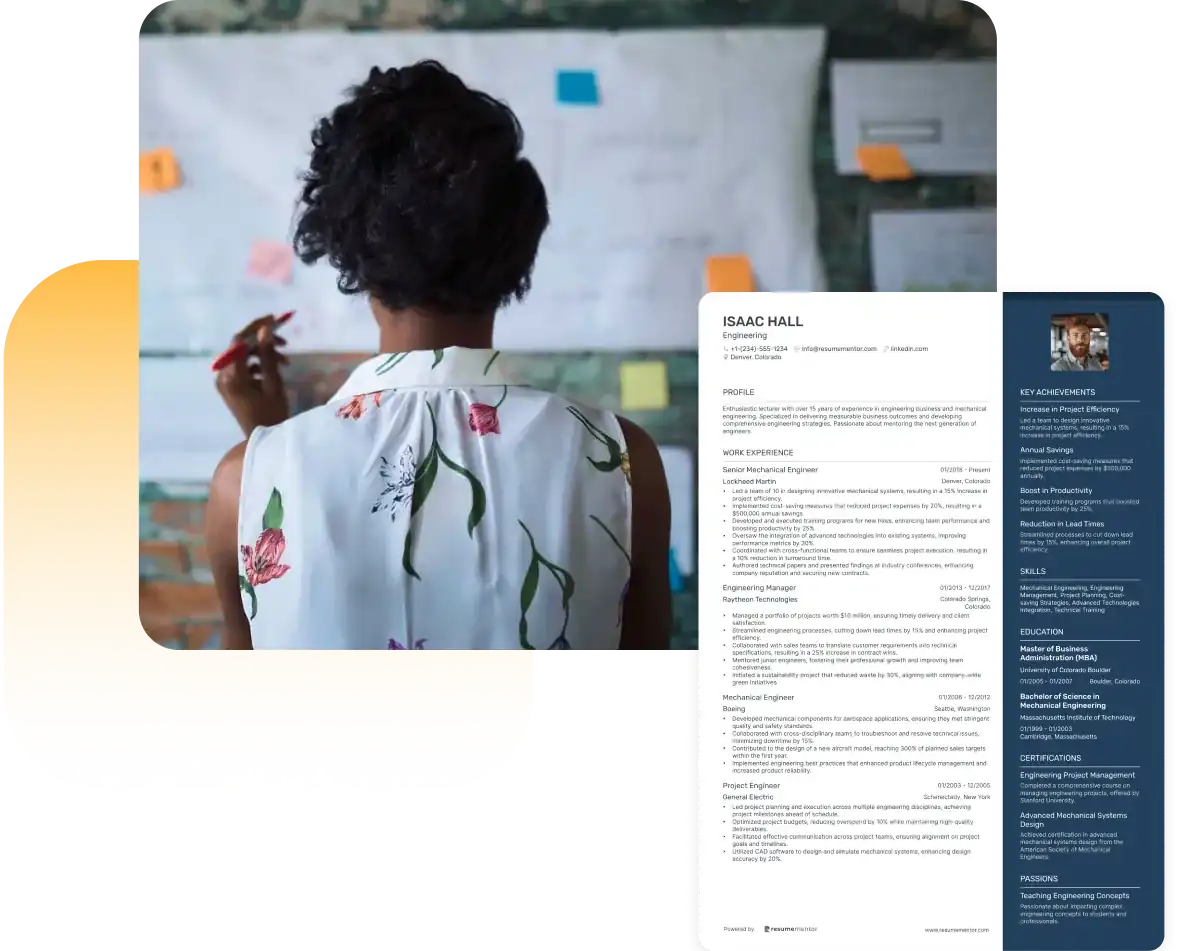
Continue Reading
Check more recommended readings to get the job of your dreams.
Resume
Resources
Tools
© 2025. All rights reserved.
Made with love by people who care.

